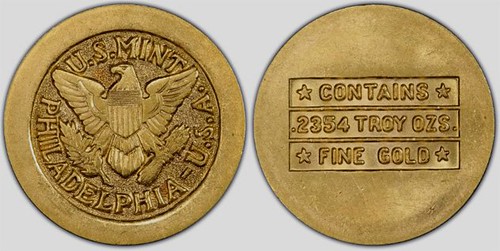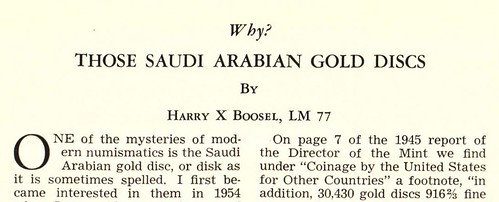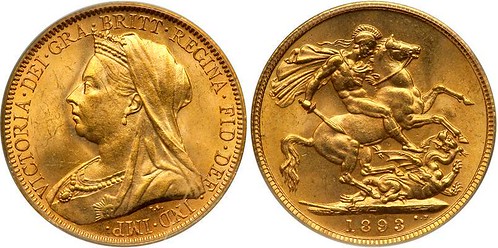
PREV ARTICLE
NEXT ARTICLE
FULL ISSUE
PREV FULL ISSUE
NEW RESEARCH ON THE SAUDI ARABIA GOLD DISCSEconomics blogger JP Koning submitted a new research piece on the 1945 and 1947 U.S. Mint gold discs. Thank you! He originally published it as a guest blog piece on Bullionstar. Here's an excerpt- see the complete article linked below. -Editor I stumbled on some strange gold discs earlier this year. They’re pictured below:  As you can see, the front of the gold disc has been stamped with the emblem of the U.S. Mint, specifically that of the Philadelphia mint. On the reverse side, contains details about weight and purity. But while they are shaped like a typical coin, the discs are curiously anonymous. Unlike a typical coin they have no date, denomination, issuing country, or the face of some dead President or royal. What are these odd discs and why were they produced? They’re pictured below: The ARAMCO connection “This Gold disk was made by the U.S. Mint in Philadelphia for ARAMCO (Arabian American Oil Company). ARAMCO needed them to pay royalties to Saudi Arabia for the right to start drilling for the vast oil reserves known to be there, and to help alleviate the shortage caused by the record consumption during World War II.” The reference to ARAMCO immediately jumps out. This is one of the most provocative and persistent details of the discs’ mythology: that they were produced for the Arabian American Oil Company, or ARAMCO, in the 1940s so that it could pay the Saudi government for oil. Comprised of a consortium of U.S. oil companies that included Standard Oil of California, Texaco, Exxon, and Mobil, ARAMCO explored and developed oilfields in Saudi Arabia. The association of these disks with ARAMCO pops up everywhere on the internet. Heritage Auctions, the world’s largest collectible auctioneer, declares to discs to be “Aramco gold.” The Deutsche Bundesbank, Germany’s central bank, recently added the discs to its 90,000 coin collection. It describes them as being struck by the U.S. Mint on “behalf of the Arabian American Oil Company.” Boosel’s pet theory Boosel learnt that the Philadelphia Mint had produced two types of discs. A larger one in 1945 contained 0.942 oz of gold, while the smaller 1947 version contained a quarter of that, 0.2354 ounces. The Mint had produced 91,210 of the original 1945 issue and 121,364 in the second batch.  The letters that Boosel received in response to his inquiries further indicated that the order had been filled by the U.S. Mint on behalf of the Saudi government. The gold had been purchased by the Saudis from the U.S. Treasury by converting U.S. dollars into gold at the statutory $35 rate. This was back when the U.S. was still on a gold standard and the gold window was still open. The gold in their possession, the Saudis had then asked the U.S. Mint to turn it into discs. This wasn’t the first order that the Mint had completed for Saudi Arabia, one of Boosel’s correspondents pointed out. It had previously produced silver riyal coins as well as copper “girshs”. But Boosel was annoyed. Although he had managed to fill in much of the detail surrounding the mysterious Saudi gold discs, he still didn’t know why they had been commissioned. His frustration was such that he concluded the paper by supplying his own pet theory, that the U.S. Mint had produced the discs for ARAMCO. Boosel tells us that gold was in short supply during and after the war, so it traded at a large–almost double!–premium to its official price of $35. Which is true. ARAMCO didn’t want to pay such a high price for gold, he claims, and thus went to Uncle Sam to get discs. Boosel provided no documents to back his contention. Boosel’s shot-in-the dark ARAMCO theory has since gone on to become part of the accepted canon surrounding the discs. A 1991 New York Times article about the discs, for instance, notes that: “Aramco sought help from the United States Government. Faced with the prospect of either a cutoff of substantial amounts of Middle Eastern oil or a huge increase in the price of Saudi crude, the Government minted 91,120 large gold disks adorned with the American eagle and the words “U.S. Mint — Philadelphia.” Aramco paid for the minting and the bullion. The coins were shipped off to Saudi Arabia.” By the 2000s, coin retailing websites were eagerly repeating Boosel’s ARAMCO theory. Can you blame them? A tie-in with the oil industry spices up the discs’ history. And a provocative mythology can boost their market price. Although a 1945 disc contains just under an ounce of gold, it sells for US$2,749 on APMEX. A regular gold coin that contains one ounce of gold, say an American Eagle, currently retails for around US$1250. The market evidently attaches a very large premium to the rarity and unique history of the Saudi gold discs. New documents surface Boosel is certainly correct that ARAMCO needed gold to pay for oil. When the Saudi monarch Ibn Saud and ARAMCO inked their deal in 1933, the terms of the deal stipulated that for each ton of oil produced, ARAMCO owed the Saudi government a royalty of four gold shillings. This amount was payable in gold sovereigns, a British coin that circulated widely in the Middle East at the time. Each sovereign contained 0.2354 ounces of gold.  1893 British Gold Sovereign It seems logical, therefore, that in light of the rarity of sovereigns, ARAMCO might have contracted with the U.S. Treasury for gold discs. That the discs were stand-ins for sovereigns is underlined by the fact that the Philadelphia Mint had produced the 1947 issue with the exact same specifications as a British sovereign.3 Both sovereigns and discs contained 0.2354 ounces of gold and were of a fineness or purity of 0.9167. Despite the attractiveness of Boosel’s ARAMCO theory, the FRASER documents do not bear it out. In each instance where discussions about the discs occur, they specify that the discs were made for the Saudi government, not ARAMCO. Boosel’s ARAMCO theory is even more unlikely given that the transaction would have been illegal. Under the rules governing the gold standard of the day, the Treasury was prohibited from selling gold to private companies. When the U.S. had gone back on the gold standard in 1934 after a hiatus beginning in 1933, the terms of redemption had been altered. Whereas everyone had historically had the right to convert U.S. dollars into gold, after 1934 only foreign governments were permitted to convert dollars into the yellow metal. Additionally, all U.S. gold coins were demonetized and private ownership of gold declared illegal. So ARAMCO didn’t have the right to purchase gold from the Treasury. Not only that, but it would have been illegal for ARAMCO to store the discs on U.S. territory once received. In Conclusion The story of the Saudi gold discs also illustrates the bewildering variety of monetary arrangements that have existed across the globe, even within the same era. How strange is it that the U.S., which itself had banned gold coins only a few years before, found itself in the position of minting gold coins for a nation that was still wholly dependent on precious metals? Monetary systems are often full of surprises like this. To read the complete article, see:  Wayne Homren, Editor The Numismatic Bibliomania Society is a non-profit organization promoting numismatic literature. See our web site at coinbooks.org. To submit items for publication in The E-Sylum, write to the Editor at this address: whomren@gmail.com To subscribe go to: https://my.binhost.com/lists/listinfo/esylum All Rights Reserved. NBS Home Page Contact the NBS webmaster 
|